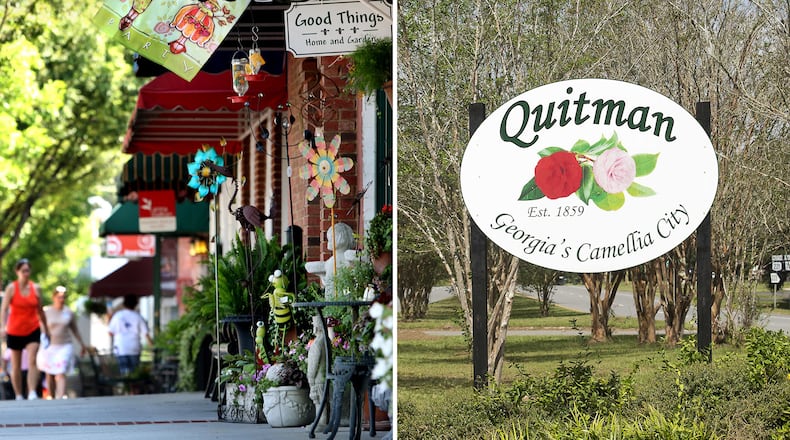The two Georgia counties with the biggest partisan shifts over the past decade could hardly be more distinct from each other.
No county has experienced a greater jump in Democratic voter participation between the 2010 and 2018 primaries than Gwinnett, a fast-diversifying suburb teeming with neighborhoods and strip malls.
And no county experienced a GOP awakening as much as Brooks, a sparsely populated, rural territory laden with mossy oaks and peach groves perched atop the state border with Florida.
Yet both also are uniquely central to November’s race for Georgia governor. Gwinnett has fast become a virtual must-win for Democrat Stacey Abrams as the county has morphed from a Republican stronghold to a pitched battleground.
And Republican Brian Kemp needs to win huge margins in counties such as Brooks, where Yellow Dog Democrats have given way to staunch conservative politics, to overcome his likely struggles in densely populated parts of the state.
The Atlanta Journal-Constitution took a closer look at the dynamic politics of these two counties, home to residents who are closely watching this election — and hopeful the next governor can fulfill bold promises.
Brooks County
The last time there was a wide-open race for Georgia governor, Republicans were outnumbered in Brooks roughly 3-to-1 in the primary contests. Eight years later, GOP voters had the overwhelming advantage — more than doubling their primary vote total — and few here are surprised.
After all, in the 2010 governor’s race, Nathan Deal lost Brooks by a few hundred votes. Four years later, he won it by about 8 percentage points. Donald Trump carried Brooks by an even vaster margin, winning nearly 60 percent of the vote here.
But residents here are also scarred from a saga that ripped the county apart eight years ago, when four black candidates won a majority of seats on a local school board that had always been controlled by whites – leading to a state investigation into election law violations that later collapsed.
Nancy Dennard is a veteran of that fight. As the president of the school board, she was charged with 11 counts of voter fraud and later exonerated after a lengthy battle. Now she’s the mayor of Quitman, the tree-lined county seat of Brooks, and she’s an Abrams supporter who’s thankful the Democrat hasn’t written off red territory.
“Her message is starting to resonate. The state is finally realizing the capabilities of Brian Kemp,” she said during a recent Abrams visit to South Georgia. “We are now looking to the future.”
Her office in City Hall sits in a tidy downtown off the straight-as-an-arrow road linking to Valdosta 17 miles away. A few blocks away, Ernie Owens runs the Owens Propane Co., a low-slung building with a steady stream of visitors on a recent weekday.
A red-and-black Kemp sign standing vigil outside the store made clear his views on the governor’s race, but he was eager to reinforce them as he leaned back in a chair near the front door.
“I like Kemp’s beliefs, his background, his family, his upbringing, his support for the Second Amendment,” Owens said, ticking through an internal list. Most of all, he added, he liked that Kemp was endorsed by Trump.
“I’ve always been a Republican, but now more people are realizing the problems we’ve had are related to the Democrats,” he said. “I’m talking about the partisan divide.”
The county’s population hovers around 15,500 people, hardly budging since 1960, and nearly 1 in 4 people live below the poverty line. Many people here feel they may as well be stand-ins for the “forgotten man” that Trump spoke about so effectively during the 2016 campaign, and they point excitedly to recent economic gains.
There’s the chicken hatchery on the outskirts of town bringing in about 100 new jobs, and there’s buzz about a big project brewing with the local development authority. Some credit Trump’s policies, and Republicans by extension, for the economic boost.
“We had to have some change, and we are getting it. The school system is getting better, building has started up again, the construction market is taking off,” Owens said. “And that’s all about the economy.”
A bit farther out of town, across from the high school football stadium, sits R.L. Cunningham & Sons Peanut Co. A few weeks from now, the plant will be bustling with activity from the latest peanut harvests. But for now, owner Larry Cunningham is enjoying a moment of downtime.
People around town see him as the county’s unofficial historian, and he’s quick to share his insights on local personalities, like the time he met Jimmy Carter at a peanut conference when he was 10. In his view, Brooks isn’t getting any “redder” — but the lines between Democrats and Republicans here are hardening.
“It’s like Methodists and Baptists who used to go to services together but now have fallen out over denominational disagreements,” he said.
That didn’t used to be the case. Generational fallout from Reconstruction put Brooks and most other rural Georgia counties solidly in the Democratic camp, and for decades the county’s top offices were filled with Yellow Dog Democrats — die-hard Southerners who voted for whatever name had a “D” next to it.
That began to change in 2010. A heated primary race for a U.S. House seat and contested school board elections divided conservative voters who were used to pulling Democratic ballots.
“Eight years ago, we still had conservatives running as Democrats. We knew who everyone was. But 2010 woke us up,” Cunningham said. “It became obvious that you couldn’t sit down and be a Republican but then vote in a Democratic primary.”
His best guess is that the governor’s race has only solidified that divide. Most people here, he said, have retreated to their ideological corners.
“The race factor is there for both sides, and some people are going to vote strictly on race,” Cunningham added, glancing over to a “Peanut Life” license plate hanging on the wall. “I don’t think there’s enough undecideds here in Brooks to fill a phone booth.”
GWINNETT
Just as Gwinnett has transformed from a rural backwater to a sprawling suburb, another metamorphosis is underway: from Republican bastion to a place that, if not reliably blue, is suddenly reliably competitive.
Case in point: Eight years ago, only 17,500 Democratic primary ballots were cast, accounting for less than one-quarter of the overall votes. This year, that number eclipsed 40,500 — rocketing to 53 percent of the total, the largest Democratic increase in Georgia.
The primary reason is a swirl of changing demographics. More than 60 percent of Gwinnett's 900,000 residents are black, Latino or Asian — a tidal shift for a county that was almost exclusively white in the 1990s. Transplants from major cities in the Northeast and Midwest are also changing the county's mix.
And though county-level positions are primarily held by Republicans, Democrats are taking aim at offices that once seemed far out of reach — including five seats in the state Legislature left vacant by departing GOP incumbents.
That's good news for Democrats hungry to lock down Georgia's second-largest county, which flipped blue in 2016 for the first time since Jimmy Carter's presidency.
That newfound energy was mesmerizing to Janice and Elhadj Allie of Lawrenceville, who were enjoying a meal near the entrance of the Gwinnett County Fair, where strains of politics competed with loud music, fried food and raucous rides.
“Definitely because she’s an African-American,” Janice Allie said when asked to elaborate on her support for Abrams.
“It would be the first time we had an African-American woman governor. And I think she’s family-oriented, she cares about the family,” she added. “That’s what we need — people who actually care.”
Just a short walk away, Roberta and Gary Dodson of Snellville sat on a hay bale eating a fried onion blossom and an ear of corn, and they quickly provided an example of how polarizing this race is.
Both said, flatly, they’re voting for “not Stacey” — for very different reasons.
For Roberta Dodson, it was Abrams' 2017 call to remove the Confederate faces from Stone Mountain that cinched her opposition. Her husband had a broader set of complaints about her campaign.
“Because she’s a liberal. And anyone that Hillary (Clinton) supports? That kind of sums it up right there,” Gary Dodson said. “It’s all the liberal things that she supports.”
The Dodsons’ comments point to an important caveat: While Gwinnett has been a majority-minority county since at least 2010, the actual voting population transitioned much more recently.
It was only October 2016 when an AJC analysis found that, for the first time, more than half of Gwinnett’s registered voters had identified themselves as something other than white.
Democratic hopes in Gwinnett, then, will likely swing on the level of turnout. The local party is confident, with Party Chairman Gabe Okoye describing this election season as a “full onslaught.”
“We want the state to go where we’re going,” Okoye said. “And we’re going blue.”
BROOKS COUNTY
Population
Estimated population in 2017: 15,587
Change since 2010: -4.5 percent
Racial and ethnic breakdown
White, not Hispanic: 57.0 percent
Black: 35.1 percent
Hispanic or Latino: 5.8 percent
Education
High school graduate or higher: 79.0 percent
Bachelor’s degree or higher (age 25 and over): 12.4 percent
Health
People without health insurance: 19.9 percent
Income
Median household income (2016 dollars): $34,547
People in poverty: 24.9 percent
GWINNETT COUNTY
Population
Estimated population in 2017: 920,260
Change since 2010: 14.3 percent
Racial and ethnic breakdown
White, not Hispanic: 37.4 percent
Black: 28.7 percent
Hispanic or Latino: 21.2 percent
Asian: 12.2 percent
Education
High school graduate or higher: 87.5 percent
Bachelor’s degree or higher (age 25 and over): 34.9 percent
Health
People without health insurance: 16.7 percent
Income
Median household income (2016 dollars): $61,865
People in poverty: 11.3 percent
Source: U.S. Census Bureau
Stay on top of what’s happening in Georgia government and politics at ajc.com/politics.
Keep Reading
The Latest
Featured








